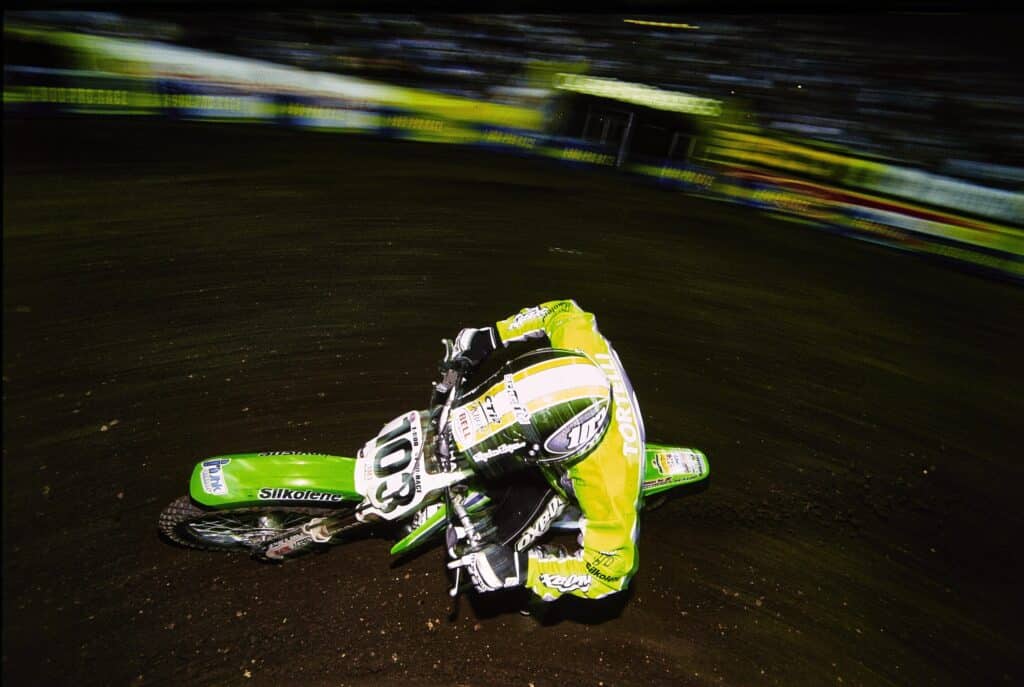Comeback in the Coliseum: The 1987 Los Angeles Supercross
By
Why the final running of the Super Bowl of Motocross was the greatest race in the sport’s history.
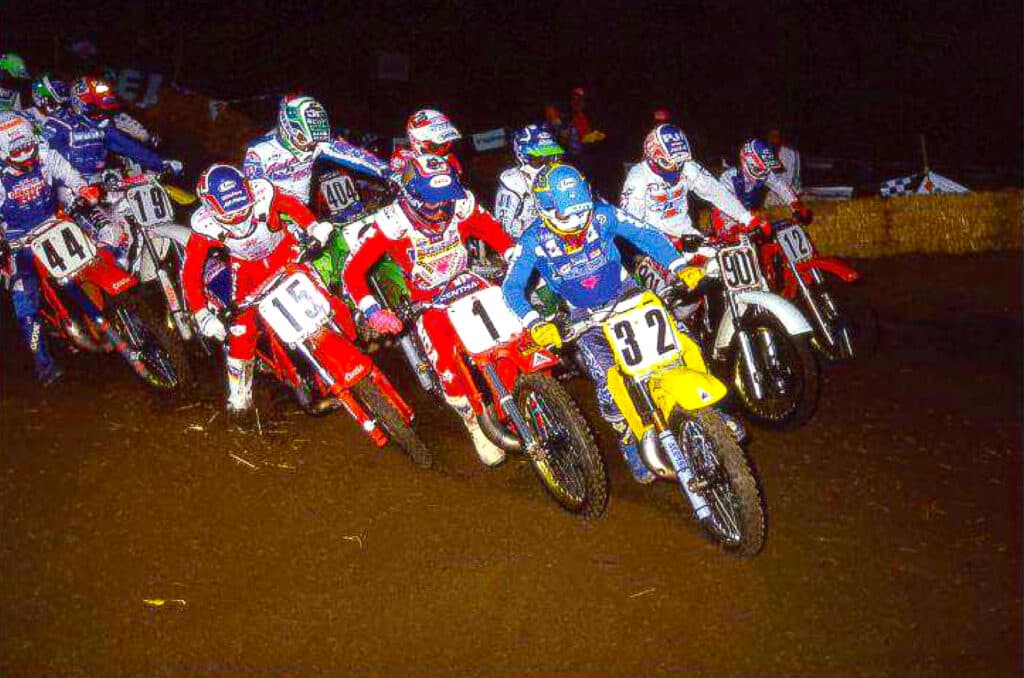
Rick Johnson goes from (almost) last to first; Wild man Guy Cooper (almost) wins; a unique but one-lined track with a short start straight and a first turn the size of a “phone booth” causes absolute carnage; Shots fired on the podium from Ron Lechien, and RJ is caught on a hot mic saying “You’d have to be a stupid idiot to follow these lines if someone faster than you was behind you.”
And Larry Huffman calling all the action.
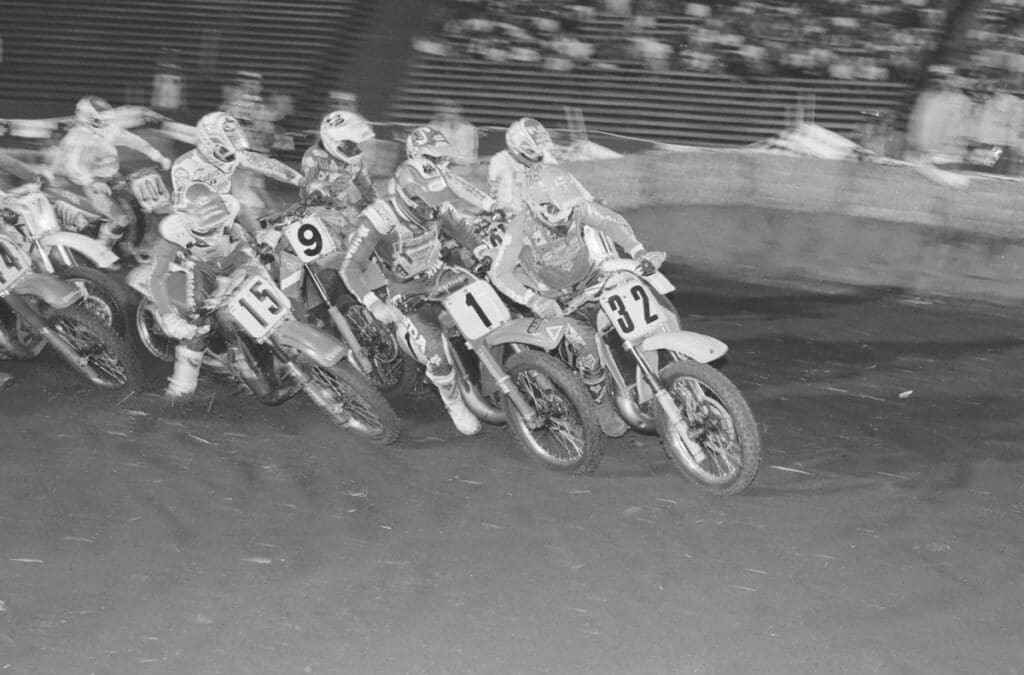
These (and more) are the reasons why I believe the 1987 Los Angeles Coliseum Supercross, the last time the “Super Bowl of Motocross” event title was used, is the greatest Supercross of all-time.
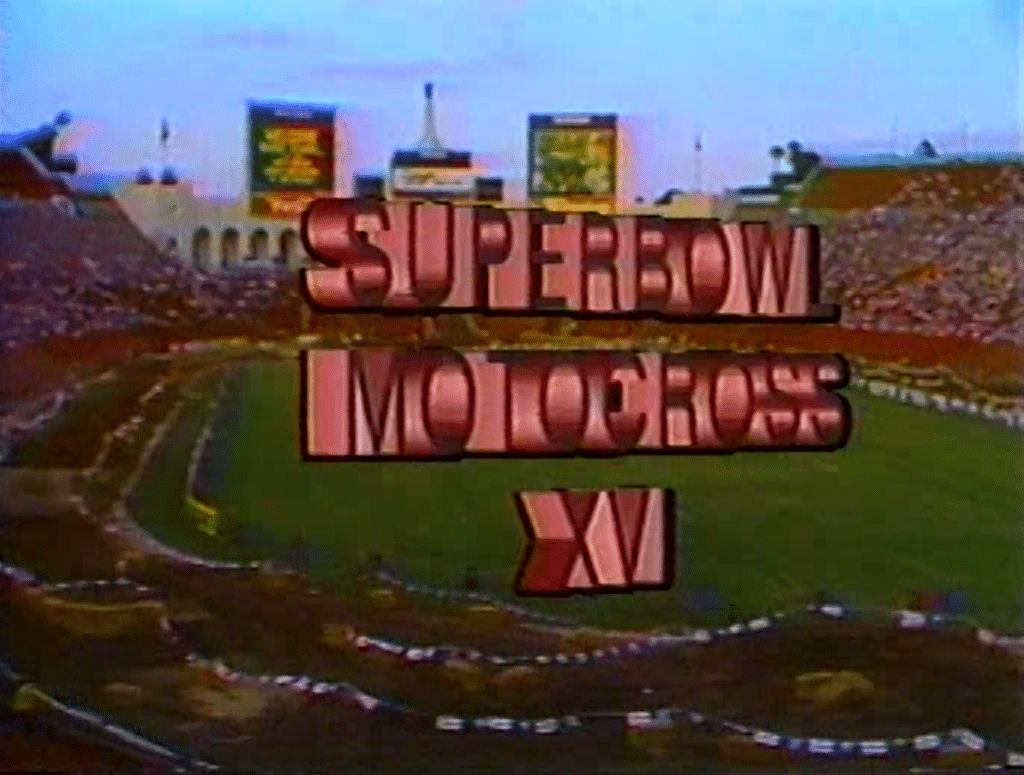
June 27, 1987. Rick Johnson’s Helmet is Stolen
Ricky Johnson couldn’t find his helmet. Searching around and behind the marble columns of the Los Angeles Memorial Coliseum, and under his fold-up lawn chair, RJ came up empty-handed when he moved to strap on his Bell Moto 4.
The rivals around him were headed down to the stadium floor where the main event of the final round of the 1987 AMA Supercross Championship was minutes from gate drop. Johnson had a look of “FML” on his face, but he didn’t look panicked. Mostly annoyed and in disbelief.
It had already been a frustrating day of dealing with a one lined track, Ron Lechien chopping off his front wheel in the first turn of the heat race, and the many obligations that came from being the most popular rider in moto and racing in LA, the birthplace of supercross. On this particular day, Johnson even had a documentary camera crew following him.
His mechanic, Brian Lunnis, told him to take the bike down to the line. They had ninth pick on what had already proven to be a problematic starting gate, straight and turn. Missing his spot in the slotting order would make it even worse.
Lunnis ran back to the Honda box van to get the spare helmet. Riders didn’t operate out of their individual trucks in LA. The ‘paddock’ was simply all the riders hanging out in the open mezzanine area within the marble columns of the peristyle section of the Coliseum.
In a text message to We Went Fast, Johnson said he occasionally gets hints about the helmet’s whereabouts. “I’ve had a couple people tell me that they had it and caught a guy in the desert with it, but I never got it back.”
Johnson rolled his Honda CR250 down the dirt-covered stairwell, onto the floor of the Coliseum.
A Weirdo Diversion Into Supercross Schedule History
The championship was moot but bragging rights were very important to RJ. Coming into the 14th and final round of 1987, Johnson had six Supercross wins to Jeff Ward’s five. Above all else, he did NOT want to let Ward even the score and win the title. Ending the season with a 7-5 record against his biggest rival set a nice tone for 1988.
Ward came into the race with a 39-point lead on Johnson but he had not officially been crowned the champion. Just a few weeks earlier, LA was not the final round on the schedule.
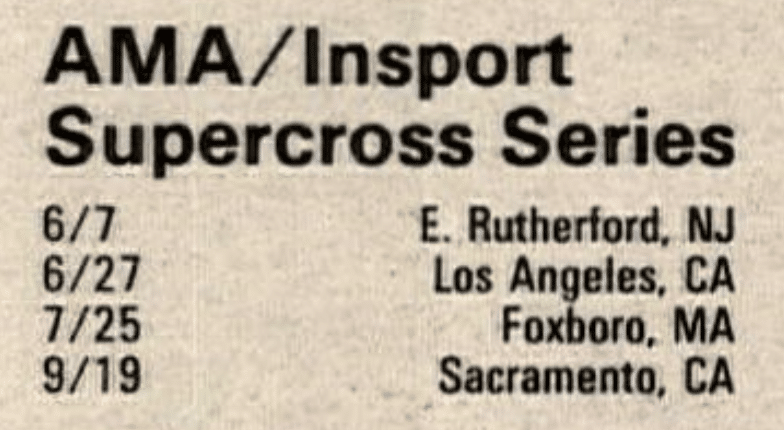
To get really weedy into Supercross history, the original 1987 schedule had 17 rounds, including a stop in Boulder, CO and Minneapolis. Neither happened.
Dates for Sacramento, Calif. (Sept. 19) and Foxborough, Mass. (June 13) were added after the season began. The Los Angeles Coliseum held its originally-scheduled date of July 25. Throughout the spring, the dates of those three events shifted several times. LA moved to June, Foxborough to July.
In early June, Foxborough fell off the calendar completely and Sacramento moved to July 25, which pulled up the LA date to June 27. In the end, neither Sacramento or Foxborough happened at all. Sacramento’s race at the Cal Expo was cancelled at some point between the June 7 Supercross at the Meadowlands and the LA Coliseum on June 27.
After the season, Ward fumed to Dirt Bike Magazine about the handling of the cancellations. “I rode hard with a severely injured ankle at the previous Supercross (Meadowlands, June 7) when in reality, all I needed was a 15th place finish to wrap up the series. It wasn’t handled very professionally.”
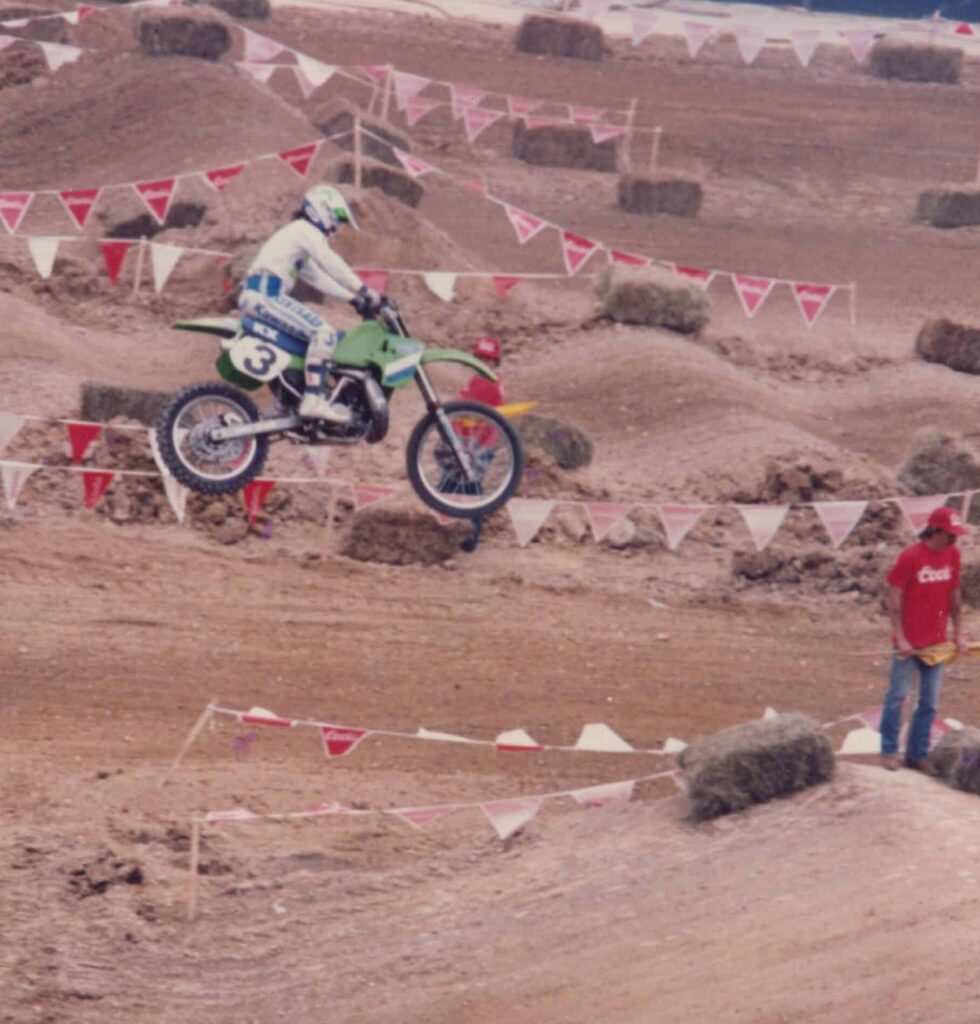
So, Johnson’s chance of fully defending his number plate was prematurely snatched away. I was a big RJ fan in 1987. I did a book report on his movie “Profile of a Champion” so learning about all this 36 years later, I’m angry for eight-year-old me who wanted to see Johnson keep the number one plate.
The season ended with Ward 34 points ahead of Johnson. Both riders raced with injuries all season but Johnson missed two rounds completely and crashed out of the opener in 1987. He no doubt had some extra motivation for wanting to make statements in LA.
Ricky Johnson: Profile of a Champion
Johnson’s frustrations early in the day were preserved for eternity when he dropped into the first practice session wearing a lavalier microphone taped to the inside of his helmet’s mouthpiece. A transmitter duct taped to his lower back sent the audio signal back to a recorder. John Bradley Entertainment had a crew in LA shooting for what became the documentary “Rick Johnson: Profile of a Champion”.
An outgoing personality, Johnson was the perfect rider to ‘mic up’ while riding. With an arsenal of nicknames–RJ, Bad Boy, Too Hip–he was like the Apollo Creed of moto. He casually narrated what he was doing on the track but pulled no punches in saying what he thought about the riders he passed during the session. “He’s kind of squirrely, but he’s good,” he said of privateer Rick Ryan, who won the Daytona Supercross that March.
After just a lap or two, Johnson couldn’t contain his incredulity about the track’s limited line choices, especially in the tricky S-turn section, a series of six sharp curves built like a slot car course. The obvious intention was for riders to select a line and stay in it until the end. But nothing prevented them from hopping in and out of the slots.
“You’d have to be a stupid idiot to follow these lines if someone faster than you was behind you,” Johnson said in his helmet during practice.
Rick Johnson during practice in LA
After the chicane-style S-turns was a whoop-de-doo section, which Johnson also derided.
“They didn’t put down any hay bales so now there’s one line through the whoops. What a joke!”
Before taking the session’s checkered flag, he yelled at a track official, “You got one line through those whoops, man!” Course workers continued to work on the whoops all evening but they never got them right.
Qualifying heat race number four was the most competitive of the night, with Johnson, Jeff Ward and Ron Lechien all on the line. Lechien veered right out of the gate and closed off Johnson’s path into the first turn.
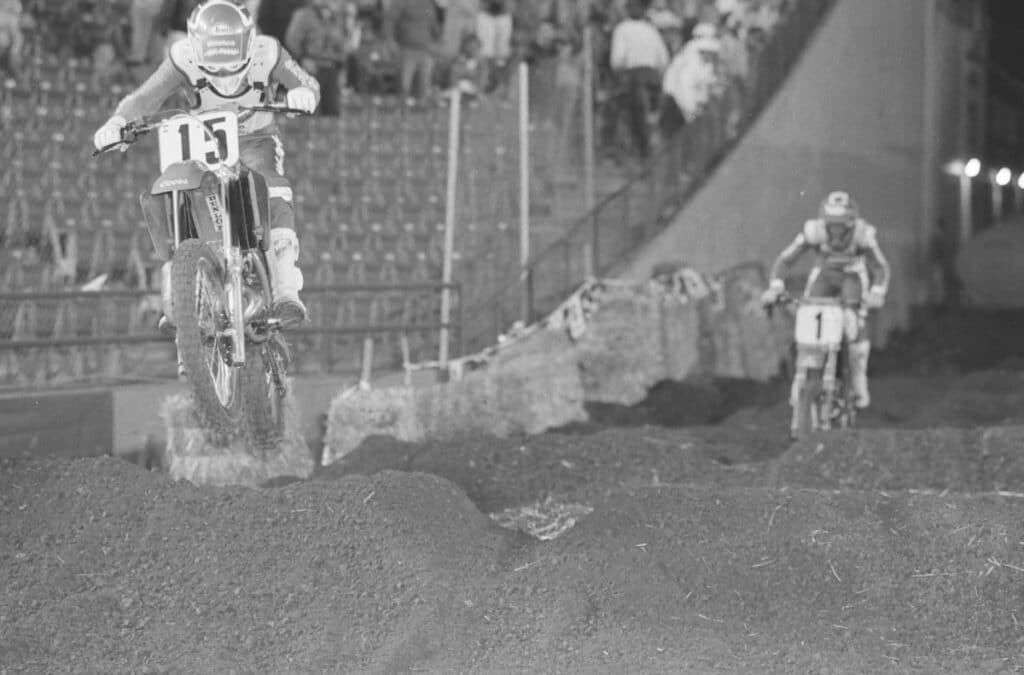
For eight maddening laps, Johnson couldn’t pass Ward. Lechien won and admitted in his post-race interview, “Yeah, I cut Johnson off on the start. It felt real good.” Lechien had money on the line, though. He won a series within the series called the Coors Cup, which awarded $4000 to the rider who qualified fastest most often throughout the season. And he got a $1000 bonus for setting the fastest heat race in LA. What’s curious about this is that Johnson won the main event yet received only $1236 for the victory.
In a phone conversation from his office at Maxima USA, Lechien said there was always tension between he and Johnson. “I did whatever I could to put him on the ground,” he says.
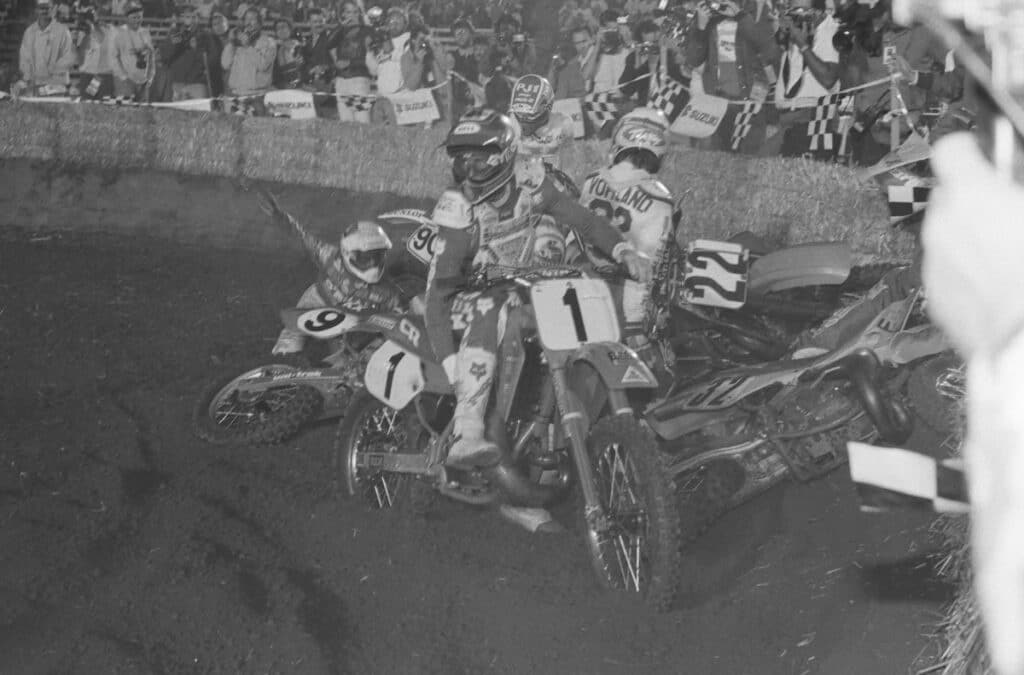
The Main Event: The Mud, The Blood and the Beer.
Legendary reporter, Shav Glick, now enshrined in the Motorsports Hall of Fame, said it best in the next morning’s Los Angeles Times
“When 21 motorcycle riders race for an opening large enough for about three of them, strange things can happen. That’s what occurred at the start of the 16th annual Super Bowl of Motocross at the Coliseum Saturday night, and the ensuing mixup led to one of the most exciting races in series history.”
The start straight was either 40, 50 or 125 feet. It depends on who was reporting. In short (sorry), it was short. Johnson said the first turn came up so quickly and was so tight, he had to shift down into first gear.
Yamaha’s Team Manager, Kenny Clark said it was about the size of a phone booth. Carnage aplenty. The original start was supposed to be atop the peristyle and go downhill. But the AMA threated to pull the race sanction if it wasn’t changed. So riders wound up getting the short end of it (again, sorry) and there were crashes on every single gate drop.
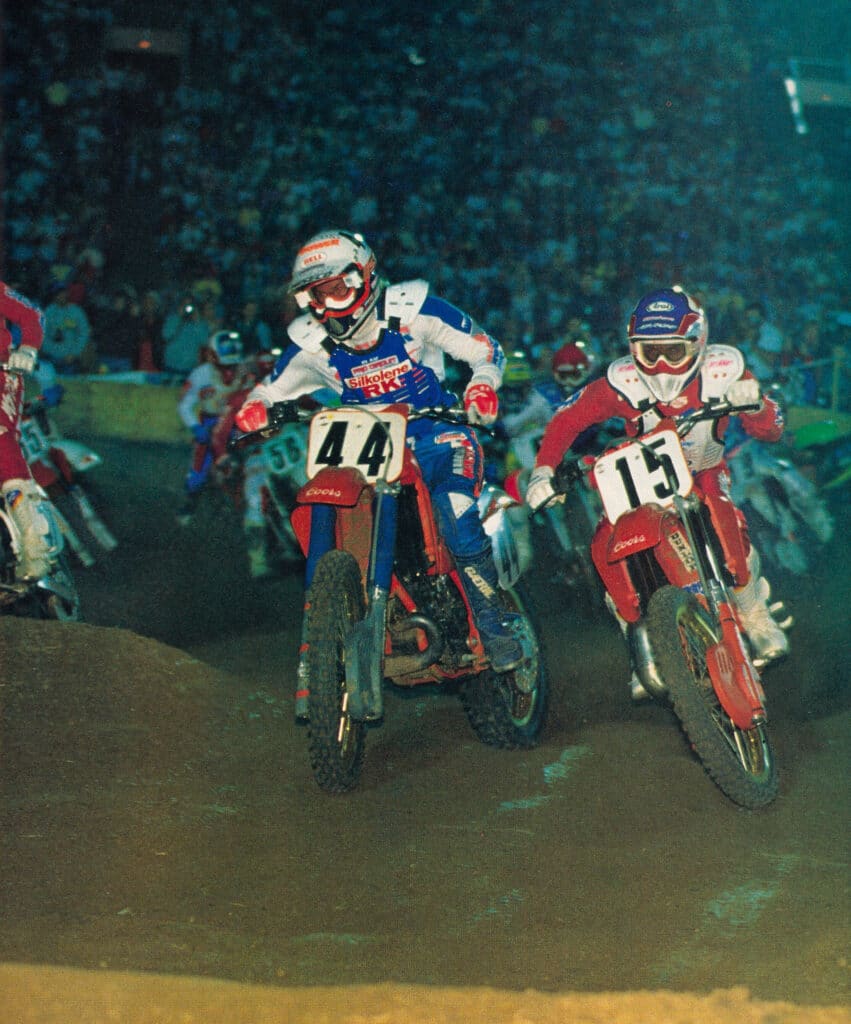
I’d embarrass myself trying to recap this main event. It’s worth 20 minutes of screen time to watch this Masterclass by Johnson, who got smashed into the haybales in the first turn and finished the first lap in 16th place.
Johnson, who couldn’t pass a single rider in eight laps during his heat race, passed them all and ran down privateer Guy Cooper who had a 15 second lead by the time RJ got into second and led 18 of the 20 laps.
As Larry Huffman so colorfully said, “Johnson’s like Sherman marching through Georgia.”
“Jeff Ward gets my number one plate but as far as tonight goes, I think I’m number one,” Johnson told Greg Barbacovi over the live event microphone after the race. “It’s not often you see someone come from last in a pileup and win. I can’t wait to watch it on videotape.”
The Videotapes Preserved it Forever
My bias about LA 1987 originates from the fact that there is enough supporting video evidence of this race that it satiated the never-ending appetite of a moto-crazy eight-year-old.
The 1987 LA Supercross was released on VHS by Jeffrey Bryan’s Motovideo subsidiary and titled “The World’s Greatest Supercross Event”. Despite the fact that it featured fake cheering crowd audio and the obvious sound of 125s revving on the starting line while the video is clearly of 250 class riders, I still loved it. And I still love it today even though I can spot the dozens of very bad edits and moments of botched continuity.
The race was also featured in the aforementioned documentary “Rick Johnson: Profile of a Champion”.
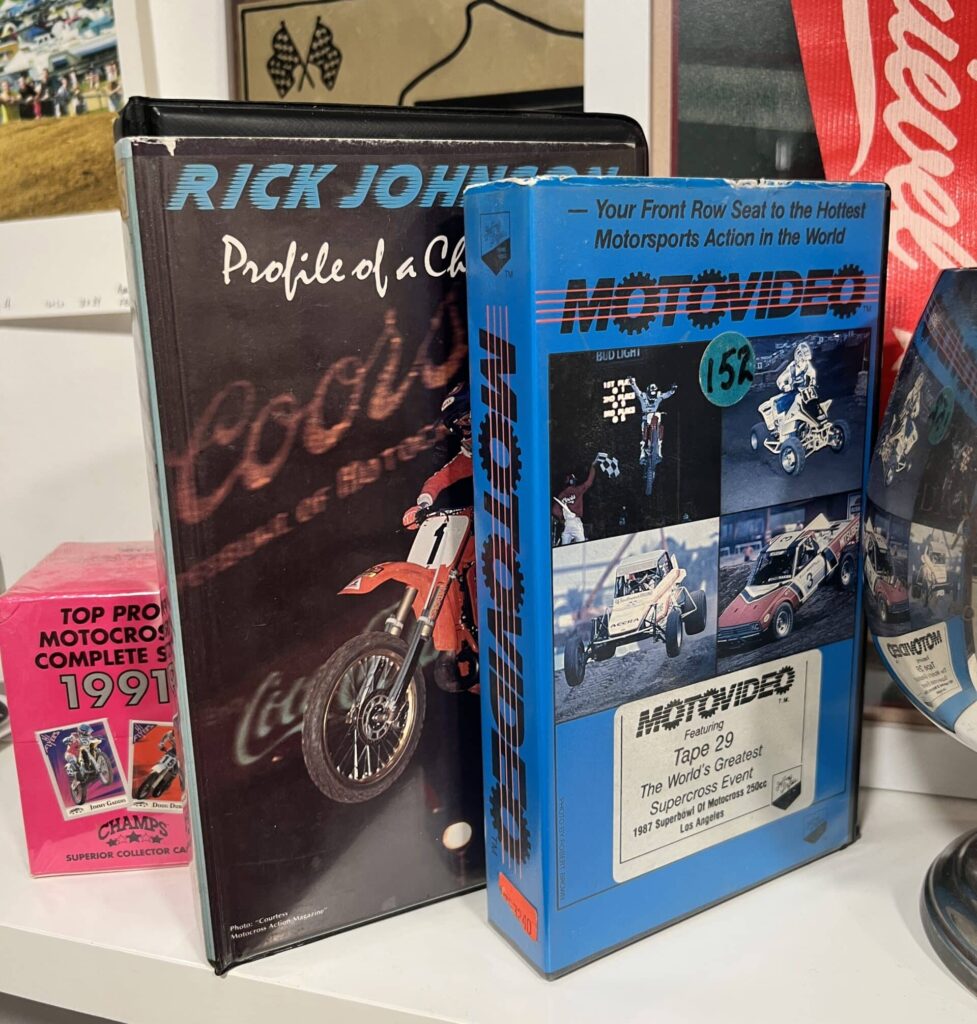
In the video library of Motosports, the parts & accessories business my parents ran in Michigan, these two titles rented for $3 a day. They were tapes #152 and #170 in our inventory. And when they were not checked out, they were in our VCR where I watched them regularly while doing homework.
My childhood home in Clio, Michigan was 2,300 miles from Los Angeles Memorial Coliseum but I spent so many hours watching these VHS tapes that it feels like I witnessed all the great moments of that era. A couple of those tapes sit on my desk today, even though the VCR disappeared two decades ago.
The original “Super Bowl of Motocross”, a Mike Goodwin production in July 1972, is the genesis of what we now know as Supercross. While lots of different stadium dirt bike racing events have been hosted in the Coliseum since (Rodil Cup, X Games, Ultracross), 24 AMA Supercross races have been held (starting with the 1972 and 1973 races, which were one-offs, not part of a series or championship.
My favorite was 1987. It’s races like this one that keep us coming back.
LA Memorial Coliseum History
Here’s a few more highlights from the other Coliseum events held between 1972 and 1998, the last time AMA Supercross dropped the gate in the Coliseum.
July 8, 1972. A one-off, three moto format motocross. It’s the genesis of what we now recognize as the sport of Supercross. 16-year-old Marty Tripes won on a Yamaha, going 2-2-2 for the overall victory. Noteworthy: Tripes won it again in 1973!
July 19, 1975: Jimmy Ellis wins, completing the first (and only) perfect season in 450SX history. The series was only four rounds long (and the final round in LA was a non-points paying event) but c’mon. Let’s celebrate the guy.
May 11, 1985: The LA round is the 10th stop of an 11-race series and David Bailey became the 8th different winner! Nearly 40 years later, it’s still the largest variety of winners in a single season. Every single one of those eight riders is now in the AMA Motorcycle Hall of Fame.
July 11, 1992: Stanton stuns, Bradshaw bombs. The season finale was postponed several weeks due to rioting in LA and the rescheduled race was held in the day time. Bradshaw won a then-record nine main events that year and Stanton just two, yet the man we now call 6-time was just six points behind coming into LA. And with Jean-Michel Bayle only 10 points back in third, three riders had a realistic shot at the title. Bradshaw needed just 3rd or better, if Stanton won.
Stanton took his third victory of the sesason. Bradshaw started 4th, never fell, or crashed, and finished… 5th.
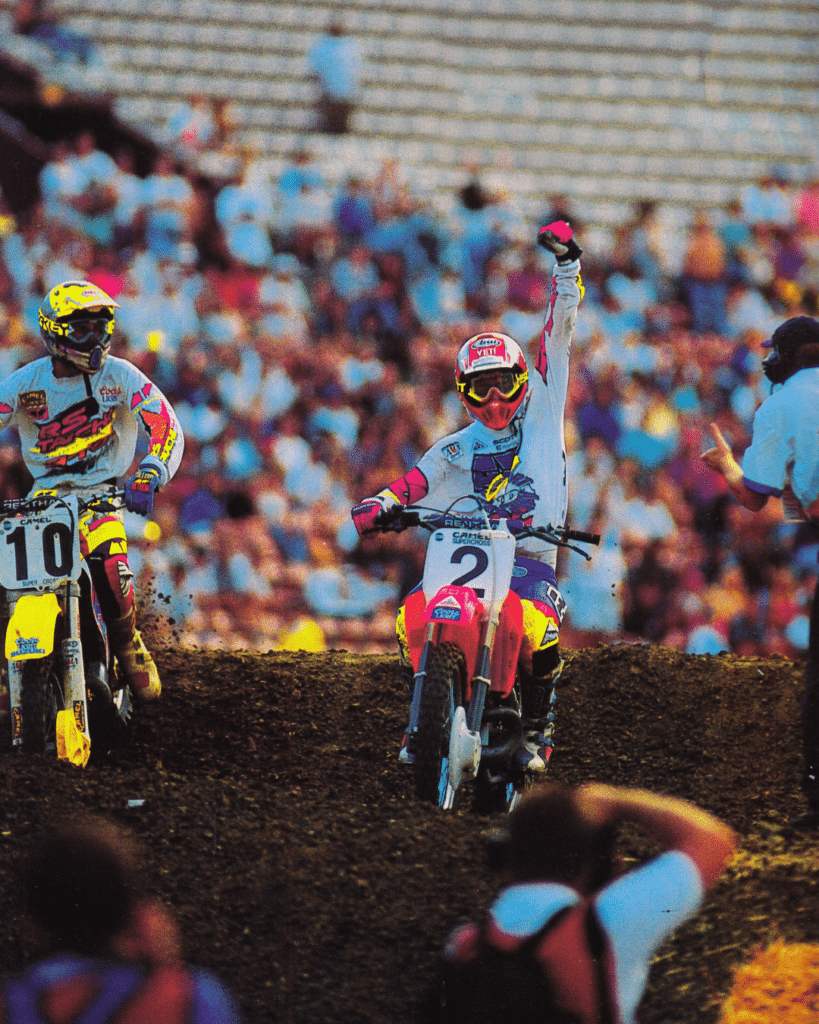
Jan. 11, 1997: The first ever (and still only) African 450SX winner. Visiting the Coliseum for the first time since 1992, the first two rounds of the ‘97 season happened in LA.
Round 1 was notable because it was defending champion, Jeremy McGrath’s first race on a Suzuki RM250 but instead of winning, which he had done at the opening rounds in 1994, 1995 and 1996, McGrath finished 15th and his teammate, South African Greg Albertyn, who struggled famously in Supercross, won. It was the only SX win of his career.
Noteworthy: This was the first running of the KTM Jr. Supercross. Mike Alessi won. Oh, and Fabio attended the race…
Jan. 18, 1997: Deegan sends it in the 125 WSX main. Here’s what’s almost more shocking than what Brian Deegan did at the end of the race: one week earlier, he didn’t even qualify. He crashed in his heat race and sat out the rest of the night.
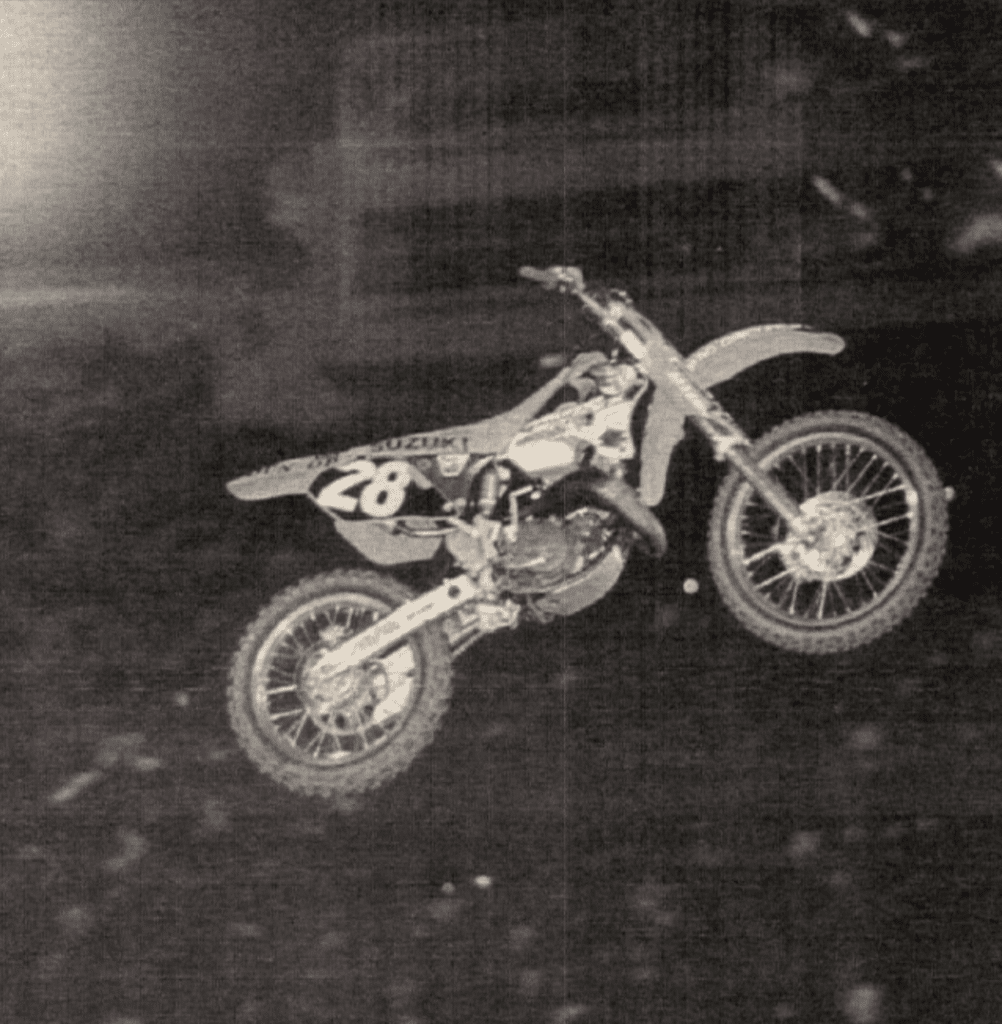
At round two, he competed with two compressed vertebrae in his back, took over the lead from Robbie Reynard on lap 12 and ghost rode his bike over the finish line. He was fined $500 by the AMA (and so was his mechanic for running out onto the course).
“I just thought that would be the punkest thing I could do,” Deegan told Cycle News after the race.
Noteworthy: Ricky Carmichael competed in his first ever Supercross that night (11th) and two title hopefuls, Kevin Windham and David Vuillemin, were also in the race.
January 10, 1998: Sebastien Tortelli wins the last AMA Supercross held in the Coliseum. It was also Tortelli’s only SX victory.
